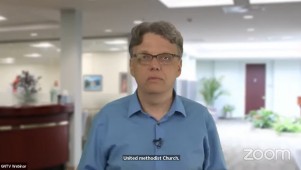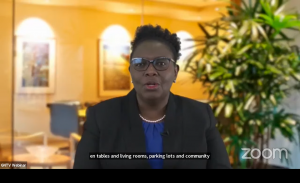news article
2021 Leadership Report: Working toward a vital future in UNY
June 17, 2021 / By Shannon Hodson / .(JavaScript must be enabled to view this email address)
What is it going to take to increase the capacity of Christ-following leaders in Upper New York (UNY)? This question was answered in the 2021 Leadership Report.
The Rev. Bill Gottschalk-Fielding, Upper New York (UNY) Director of Connectional Ministries and Executive Assistant to the Bishop, introduced the 2021 Leadership Report by acknowledging the leadership that pastors and lay leaders throughout the Conference accomplished in likely the most difficult year that a ny of them have ever faced.
ny of them have ever faced.
He said, “Over the last year and a half, you and your fellow local church leaders have led your churches through one of the most difficult and challenging times ever faced by the United Methodist Church. You’ve had to figure out how to do ministry amid lock downs, mask mandates, and COVID infections. You needed to learn how to live-stream worship services, apply public health mandates, and interpret CDC data. You’ve needed to share a comforting word with people facing infection, sickness, fear, anxiety, even death; and a challenging word with people who need to speak out and stand against racial injustice.”
A story of hope was then shared, and Rev. Gottschalk-Fielding encouraged everyone to seek out more stories of hope through Conference Communication channels and local church connections. He also shared that a lot of hopeful stories begin with the work of the Conference Leadership Team and Conference Operational Team, before letting members of those teams share.
UNY Conference Lay Leader, Drew Griffin described how both the Conference Leadership Team (CLT) and the Conference Operational Team (COT)continued working together to provide vision and direction for the UNY Conference.
Drew explained how both teams use the L3 Model (Loving, Learning, and Leading) in their meetings, emphasizing that “The Conference Operation Team and Conference Leadership Team return again and again to the Mission, Vision, and Primary Task of the Conference, ‘to increase the capacity of Christ following leaders.’”
Leadership Team return again and again to the Mission, Vision, and Primary Task of the Conference, ‘to increase the capacity of Christ following leaders.’”
Drew described the tasks of the CLT:
- Working in cooperation with the Bishop, Cabinet, and other appropriate teams to guide and maintain a culture of alignment throughout the Conference.
- Partnering with and equipping District Leadership Teams (DLT) for visioning within their local contexts.
- Engaging in strategic planning to discern outputs for UNY that best accomplish the primary task of the Conference and Evaluate Conference ministries’ contributions to those outputs.
He then clarified that the purpose of the COT is to focus on the adaptive work, strategizing pathways to accomplish the mission and vision. Drew said the COT does this using Ministry Action Plans (MAPs). He explained, “The primary MAP that we engage with is all about Discovering, Developing, and Deploying Christ-following transformational leaders (CFTLs).
Drew outlined the characteristics of a CFTL:
- Fostering a culture for people to be open and available to the work of the Holy Spirit
- Understanding the gifts and needs of their ministry setting
- Equipping a disciple-making culture.
- Discovering, developing, deploying, and leading new and existing leaders
- Inspiring and equipping others for works of evangelism, justice, and mercy
- Building a culture of transformation that will outlast the leader
- Creating, leading, and empowering a system of accountability to the mission
The leadership of each Region in the Conference has been meeting together regularly to help Discover, Develop, and Deploy CFTLs in the contexts of their Regions.
The Rev. Nola Anderson, District Superintended of the Crossroads and Finger Lakes Districts, encouraged the conference attendees to “Imagine” what the reality of vital leaders accomplishing the mission of the United Methodist Church, to “make disciples of Jesus Christ for the transformation of the world.”
Imagine… “
Rev. Anderson described the future that the CLT, COT, and Regional Leadership teams envision, in quantitative terms, as they live into an ambitious and transformative goal to, “Develop 1,800 Christ Following Transformational leaders and Deploying 900 Christ Following Transformational Leaders by 2025.”
Rev. Gottschalk-Fielding ended the report by discussing how the need to develop CFTLs has never been greater with the reality of how the pandemic has changed us, challenges that local churches have faced long before the pandemic (Secularism, financial constraints, dwindling membership, aging buildings, racism, hyper-individualism), and the uncertain future of the United Methodist Church.
Rev. Gottschalk-Fielding ended the report on an encouraging note; he said, “…one thing does seem clear: we’re going to need Christ-Following-Transformational-Leaders, both lay and clergy, to help our churches navigate this new world. And the good news is, Christ surely intends to provide such leaders. They are among us. Just look around your church. Or look in the mirror.”